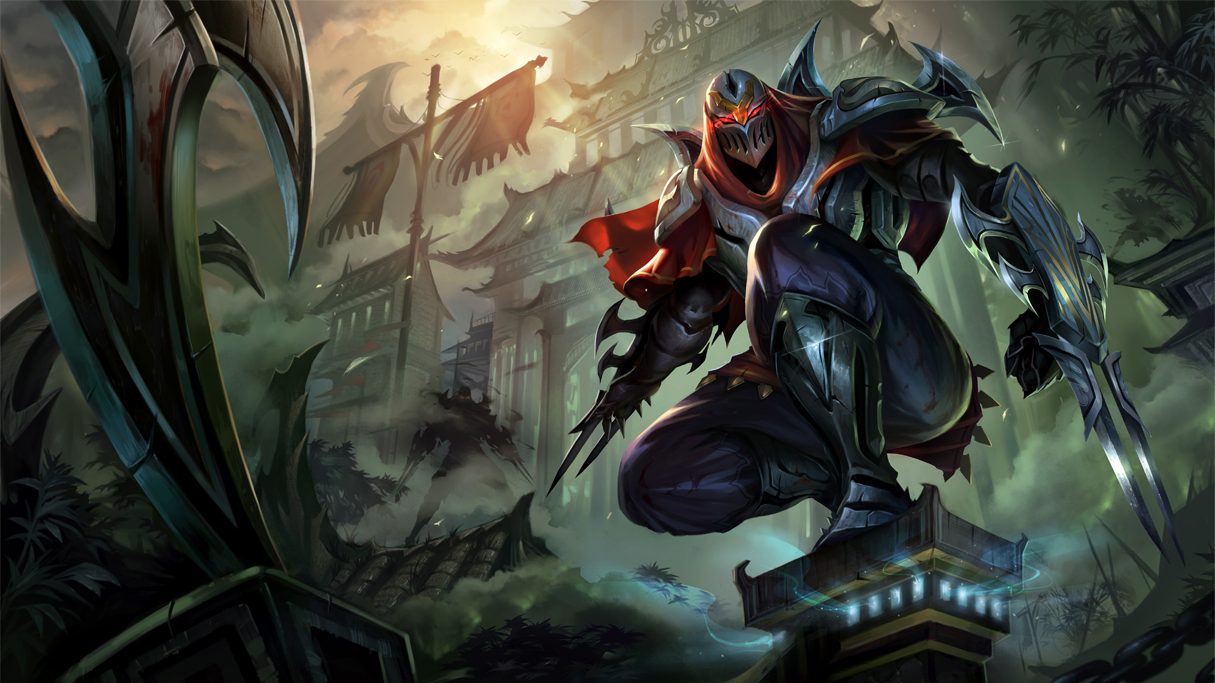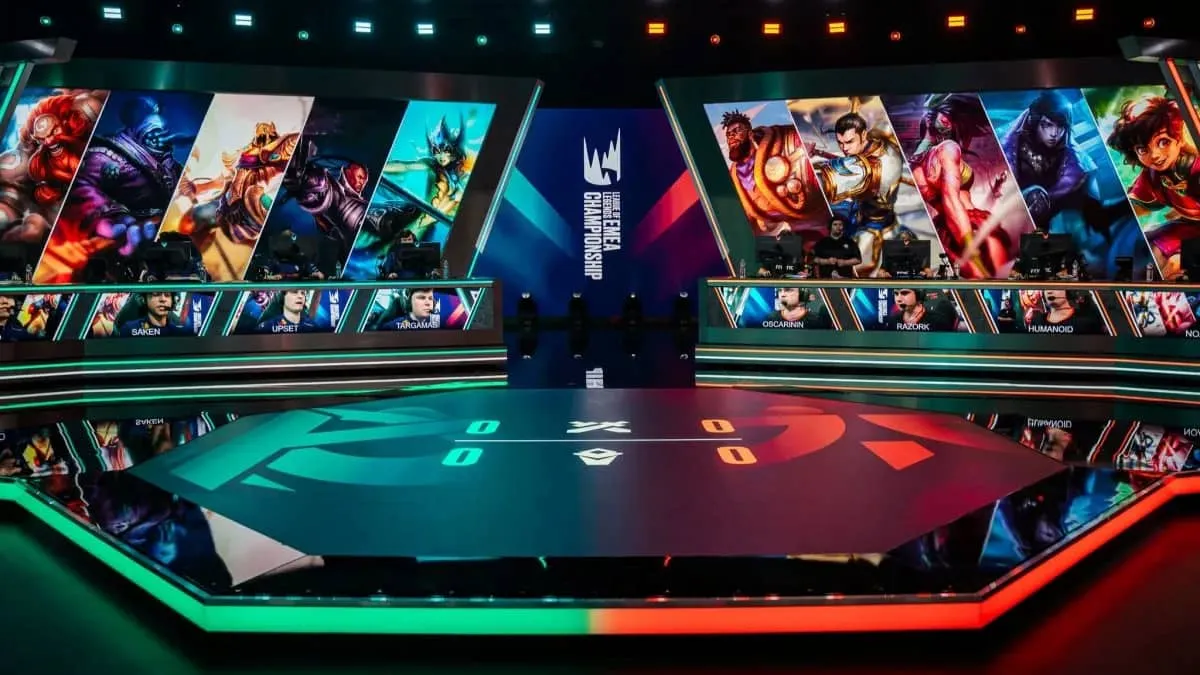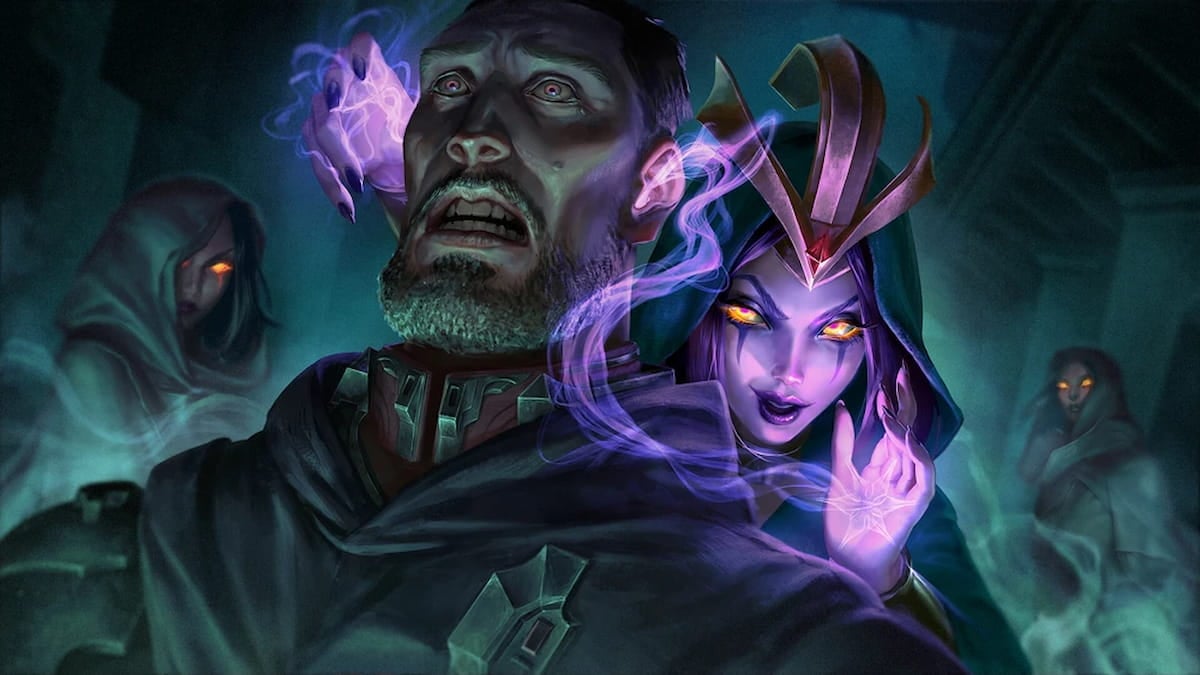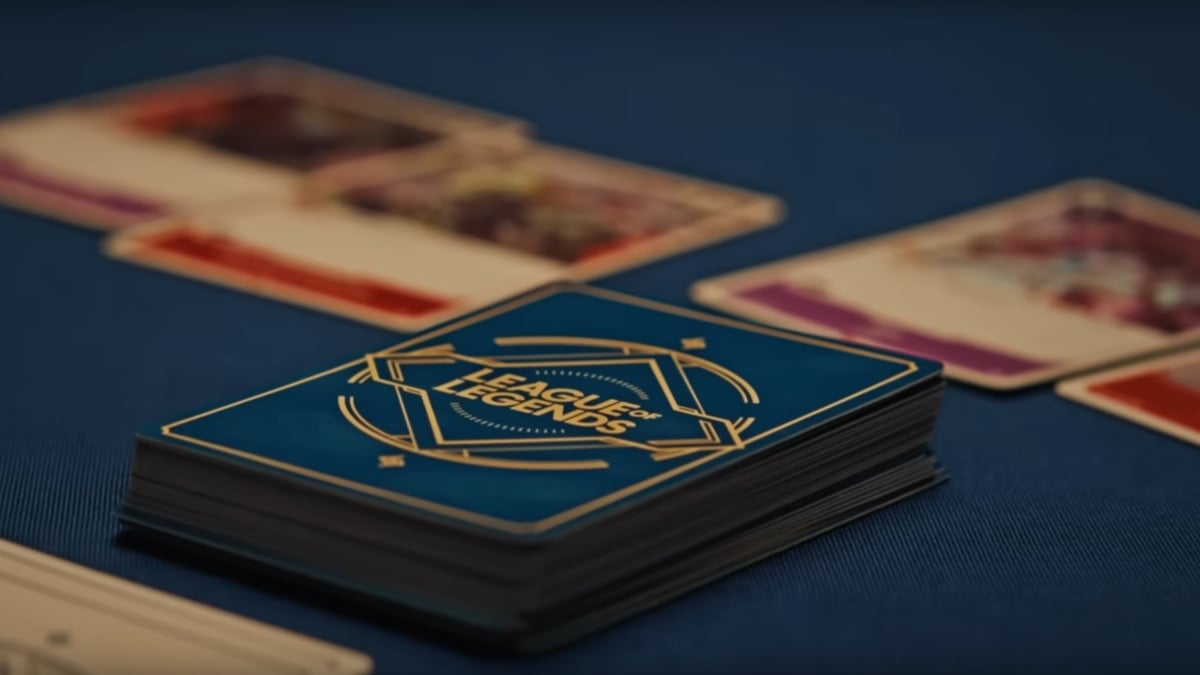Inspired by Thoorin’s “Bring me your experts” video, I decided to do a series about signature champions. My goal with this series is to establish historical context by exploring who I think are the best players to ever play those champions. This series will give an in-depth history of a champion’s competitive history and showcase some of the best Summoners to ever call them forward.
Last installment: Lulu

It’s the most famous play in League of Legends history. Two ninjas facing off. One a black shadow, the other a white bolt of lightning. With Faker on the brink of death, Ryu charges forwards to finish him off. With his team behind 10 kills in the climatic game of the OGN finals, this is his chance to turn the tables. Both players give it their all in a display of skill that requires multiple views just to figure what happened. But as the dust settles, it’s Faker’s black ninja who walks away victorious as Ryu’s Zed explodes in a shower of red.
To many fans, Zed, the Master of Shadows, has always been one of the most prolific champions in competitive play. With his damage and great mobility, Zed is a champion that can constantly score the highlight reel plays that fans are looking for. First introduced in the pre-Season 3, Zed wasn’t a mid laner. First seen in the jungle and then the top lane, Zed’s legend has spanned three years of League of Legends history. Some characters, like last installment’s Lulu have become synonymous with a single great player. Zed defined not only a World Championship, but the careers of countless LoL greats.
Tradition is the corpse of wisdom

While modern fans may associate Zed with names like dade or Bjergsen, there was once a time when fans believed that legendary jungler inSec would go down as the greatest Zed of all-time. Playing on little-known team CJ Entus (coincidentally alongside future two-time OGN MVP dade) inSec became known for his heavy carry jungler style and brilliant mechanics. With teammates like Space, kkinsh, and the infamous LongPanda, he needed it. (That ill-fated squad is perhaps best known for falling prey to PoohManDu’s jungle Heimerdinger strategy.)
Refusing to play traditional support picks like Amumu or Maokai, inSec instead gravitated towards bruisers and assassins. While his Lee Sin would eventually eclipse his Zed in fame, the Master of Shadows was clearly his first love. Although inSec’s revolutionary approach to the jungle would completely change the approach of countless junglers around the world, no player was able to copy inSec’s Zed style. His style of rushing Mobility boots to heavily farm both the jungle and enemy champions made Zed look ridiculously broken but when other junglers, even the incredibly versatile Diamondprox, tried to play Zed, they weren’t able to execute the champion. (Diamondprox’s first competitive attempt to play Zed ended up in a disappointing loss to Team Curse, in part due to his poor mid-late game execution.) Most players failed to gank on a champion that only had weak crowd control on a single spell, but inSec’s strategy of going all-in and maximizing Zed’s damage allowed him to score kills regardless.
inSec’s first appearance on the international stage immediately captured the minds and hearts of Western League of Legends fans. (It’s a little-known fact that Thorin’s Zed flair on Reddit is a tribute to inSec’s former signature champion.) In his very first game at IEM Cologne, against Froggen’s CLG.EU squad, he would go up over 100 CS on enemy jungler Snoopeh’s Malphite and out-carry Froggen’s legendary Lux. Without watching the game, one might assume that inSec simply eschewed ganks in favor of farming the jungle. In actuality every single one of his teammates was worse than their laning counterparts, and inSec had to gank over and over to keep his team in the game. Rushing Mobility boots and camping top lane, he helped longPanda double Wickd’s CS even during Wickd’s prime as a powerful lane bully. After this tournament, inSec would continue to build his legend. He nearly managed to carry his CJ team past the legendary Azubu Frost in Champions Winter, taking Madlife and co. to a deciding fifth game before falling to CloudTemplar’s Shen in a lore jungle matchup. Although inSec lost the nailbiting series, his use of Zed’s ultimate to dodge Woong’s Ashe ult remains famous to this day. His Zed would prove more triumphant during his time on ktB. In the opening game of kT’s Bo3 with Gambit, inSec would finish with a 7-4-9 score on Zed and the eventual series win.
But even though players to copy inSec’s jungle style, Zed was soon going to find a more longstanding home in competitive League of Legends – the solo lanes. His high gold scaling, strong laning phase, and wave-clear meant that teams were much better served slotting them into the top and mid positions. Unfortunately, the eventual nerfs to his wave-clear (Shadow Slash used to lower its cooldown when hitting minions) that were meant to tone down his laning phase would kill him as a viable jungler. Although he would see spotty play (Diamondprox went an Elder Lizard build on him in the waning days of the original M5 lineup in mid Season 4) Zed would become a solo-lane only champion from mid Season 3 and onwards.
Do not fear the shrouded path

As inspiring as inSec was, it was in the solo-lanes that Zed would find his true home. For all the great Zed players who would come in history, it was assassin virtuoso Westrice who would begin Zed’s shift into the top lane. (At this time, most teams were convinced that wave-clear mages would always remain the most powerful mid laners, so teams were reluctant to send Zed to the mid lane.) With the failure of Epik Gamer to qualify for the LCS, never mind international competition, Westrice’s powerful Zed would stay in solo queue rather than the big leagues. However, he was one of the first to reveal the champion’s play making ability and scaling potential in the solo-lanes. Westrice’s play would spawn a long fascination with Zed that has lasted to the present day. While Zed has seen dips in competitive play since, he has never been truly out of the meta.
Zed’s time in the top lane was interesting. While the champion was very strong and had great scaling, he struggled to assassinate the bruisers and tanks that defined the meta. At a time when players like Voyboy were turning top lane “assassins” into tanks with builds like Sunfire Katarina, Zed struggled to make his mark. Eventually it took a move to the mid lane for Zed truly shine. At the time, this was a very dramatic shift. Players were still mostly enamored with the idea of mages mid. They varied team composition damage, brought strong crowd control for ganks, and brought wave clear that could stall out losing games. As mentioned before, Zed initially boasted very powerful wave clear because his shadow cooldown would lower with successful Shadow Slashes on minions. Furthermore, the addition of the powerful Black Cleaver meant that all-AD teams were much more viable. Notably, the ability of Miss Fortune to proc all 5 Black Cleaver stacks with her ult almost instantaneously meant that mid lane AD champions were much more viable. The most popular AD champion mid was Kha’Zix. By evolving his W evolution and building Tear of the Goddess, mid laners were able to enjoy the same poke and wave clear benefits of standard mids while also boasting far superior assassination power. However, Zed emerged as a powerful alternative and occasional counter-pick.
They follow the wrong master

The first great mid-lane Zed was Alex Ich. Zed’s ability to instantly delete a champion was a perfect fit for Gambit’s “see hero, kill hero” style. While it was only until near the end of Season 3 that players truly understood the power of camping the mid lane to snowball assassin picks like Zed or Fizz, Diamond’s great synergy with Alex provided an early precursor to the style that teams like SKT in Korea or Lemondogs in Europe would make famous.
Alex has always been known as the hard carry and focal point of Gambit, and indeed the team’s propensity to set him up for multiple reset kills on champions like Kha’Zix or Master Yi shows the power of an Alex Ich carry. Indeed, Alex’s Kha’Zix was probably his signature champion during this time period, and one of his greatest of all-time. On the other hand, Alex’s Zed was very team-centric. His Zed play set an early example for other mid laners to strive to – Alex revealed many of the nuances behind playing Zed to other mid laners. His use of Zed to split-push and score individual picks was unique at a time when split pushing was mostly reserved for top laners and when most teams outside of Gambit didn’t fully understand the power of 4v5 power plays. Although this skill is rare in mid laners today (perhaps only dade and Ryu were able to fully utilize this aspect of Zed) Alex also used Zed to engage favorable teamfights for Gambit. By diving into the backline and landing multiple Shadow Slashes, Alex would slow and soften his opponents, allowing Genja to finish them off. Alex’s first game against CJ Blaze at the IEM World Championship was a textbook example of how to play in this rather supportive style. While the innovations of Westrice and inSec were critical to showing the power of Zed, Alex was the true Zed master that everyone strove to follow.
Although Alex set the sample for how Zed should be played, it was never one of his greatest champions of all-time. After the nerfs to Zed’s wave-clear and damage, Alex would abandon Zed in favor of picks like Kha’Zix or Gragas. The vast majority of mid laners around the world would follow their master, temporarily abandoning Zed until a new star would rise. Dade would begin a golden age for Zed, and did so with a unique style that echoed Alex’s desire to engage fights on a champion most players struggled to even teamfight on.
Do not deny me

After Zed’s second round of nerfs, the Master of Shadows saw a decline in play and a return to the top lane. During this time, one of the more notable Zeds was North America’s Nick Wu. Nickwu was not a very strong player overall, but his individual mastery of Zed drew bans from every team in the LCS because of how proficiently and quickly he was able to combo Zed’s skills together. While Nick was a good Zed top laner, it spoke volumes that Zed had gone from battling on the IEM championship stage to the flagship champion of a bottom-tier LCS team. At this time, most notable AD mids were actually Jayce and Kha’Zix, champions that boasted wave clear and mobility that rivaled the typical mage picks. Remembering Zed’s power in the hands of Alex Ich, other players would try and bring back the Master of Shadows, but would fail repeatedly and turn back to their typical mage picks.
One such player was CJ Blaze’s Ambition, the “national mid” and Korea’s pick for the Season 3 All-Stars match. Blaze had reached an incredible 13-0 record in the OGN by playing a style highly dependent on farming up their solo-laners – Flame’s Ryze and Ambition’s Kha’Zix were feared around the world. Heading into the finals against little-known team MVP Ozone, who had upset the kT Bullets earlier to sneak into the finals, it looked like Blaze was on their way to the first-ever perfect season of OGN. A fan looking back at that MVP Ozone roster would see names like imp, Mata, and DanDy, three players who would become some of the best of all-time in their position. But make no mistake, the reason Ozone won the championship was dade and his god-tier Zed. Picking the Master of Shadows in each of his three games (all victories) dade was able to repeatedly score kills in the laning phase against Ambition’s Kha’Zix and Diana. It seemed like Ambition had simply forgotten Zed’s power in the time that he had fallen out of the meta. Not only did dade play an excellent laning phase on Zed, he reminded the world of the champion’s power as a split-pusher and pick machine. His ability to out split-push Flame and kill him in the mid game revealed the problems with Blaze’s late-game oriented strategy.
dade’s destruction of CJ Blaze spawned a Zed craze that would rapidly take over Korea, Europe, and North America. The isolated metagame of China meant that only a few players became dedicated Zed mains. While OMG’s mid laner Cool was a decent Zed, the best Chinese Zed was iG’s ZziTai. Best known for an unpredictable champion pool and an eratic style, ZziTai’s creativity was on full display when he played Zed. His herky-jerky gameplay and Zed’s inherent fluidity led to a highly unpredictable and unique style. For a particularly awesome highlight against UZI, check here.
Balance is a lie, we are the true ninjas

It’s no mistake that many of the teams that qualified for the Season 3 World Championship also boasted the best Zed players of their region. Zed would define the rest of the season and spawn major storylines in Korea, North America, and Europe. Everyone knew that Zed was broken, the question was who could abuse him best?
Korea saw the rise of three star mid laner’s whose career would be defined by the Master of Shadows. Mentioned earlier, MVP Ozone star dade, who began the Zed phase, is the most prolific Zed player in Korea history. He was so confident with that champion that he would blind pick him against any competition. His Zed style relied on heavy bullying and split-pushing, and his signature strategy was to begin teamfights by engaging onto the opponent backline with Zed from unusual angles. The next great Zed of Korea was Ryu. Fans know him better today for failing the Zed v. Zed duel with Faker, but his tactical brilliance on the champion was unrivaled. Ryu’s aggressive diving style on Zed (he would often coordinate with his teammates to simply tower dive the mid laner over and over again) allowed his teamfights to score objective after objective. Whereas dade played Zed as his team’s main teamfight carry, Ryu often would sacrifice himself for the team’s greater success. CJ’s GBM was also a fairly notable Zed player, who went an unusual build focusing on Sword of the Divine, but he was nowhere near the level of his Korean rivals, and a critical failed shadow in the playoffs led to mockery and a historic revision of his Zed play.
The final great Zed of Korea was Faker. Faker has mastered countless champions in his career, including LeBlanc, Orianna, Karthus, and Ahri, but his Zed was arguably his deadliest. Playing on a mechanical level that has never been rivaled, Faker’s Zed quickly became a must-ban against SK Telecom. Back in Season 3, Zed’s shadow speed was significantly quicker, meaning that mechanically brilliant mids could easily crush inferior opponents. To Faker, everyone was an inferior opponent. Faker’s greatness on assassins established SKT’s overall style. Because Faker was always able to reliably crush lane and score picks, they were able to steamroll opponents in the mid game and set up Piglet split-pushes.

In the LCS, the Summer Split counts for everything. Therefore, there were no “legacy Worlds berths” like what NaJin Sword received. (Although they had a strong showing at Worlds, the team had been on a months long decline after MakNooN left the team and largely qualified off of strong NLB performances and the points that their OGN Winter championship under MakNoon scored for them.) Consequently, the three best Zed players in NA were the three players headed to Worlds. Interestingly, the three North American Zeds mirrored their Korean counterparts. Hai’s team-centric and objective style for Cloud9 paralleled Ryu’s tactical Zed. Although Reginald’s Zed was frequently mocked for his bizarre decisions, his ability to engage and teamfight on Zed resembled the hard carry Zed of dade. Finally, mancloud’s propensity for picks and solo-kills showed an American version of Faker’s bloodthirsty Master of Shadows. (Of this group, Hai has remained the only active Zed player, and also the historically greatest.)
While the North American Zeds were not as talented as their Korean counterparts, many modern day fans forget the power of Reginald and mancloud, two mids who faced severe declines in the following seasons (Reginald due to retirement.) Reginald’s Zed play was particularly interesting. When one thinks of Reginald’s career, one is reminded of a mix of overaggression and daring engages. His Zed was just like his Karthus, Diana, and Morgana. Most teamfights, Reginald focused on jumping into their backline and landing a daring double Shadow Slash, dealing massive AoE damage. Although his Zed play was admittedly clownlike at times (a comical video came out comparing one of his hamhanded Zed play to Faker’s solo-kill on Ryu), his determination to kill and synergy with TheOddOne meant he was more often than not a force to be feared.
In Europe, Zed represented the rise of a new generation. While the older generation of mids (xPeke, Alex, and Froggen) were the strong Zed players, they all seemingly preferred to play other champions. While Froggen has always had an underrated assassin game, his determination to pick mages meant that his Zed fell by the wayside. Likewise, Alex and Peke preferred other assassins, such as Kassadin or Ahri, when their teams needed burst damage. The two great Zeds of Europe were nukeduck and Bjergsen. Both players played a very mechanically intensive style, focused on dominating the laning phase and snowballing themselves to victory. With a superior team and jungler, nukeduck captained Lemondogs to the World Championship. (Interestingly enough, it was actually his teammate Zorozero who became the first European Zed master. His laning knowledge and wide champion pool made the Master of Shadows a great fit for his playstyle because he could always all-in at the appropriate time and zone otherwise.) While Bjergsen’s Zed was just as good, he would have to watch the World Championships from home for Season 3, but would rise to his throne soon enough.
Zed went on the define the World Championships. Teams that could play Zed rose to the top, and teams that couldn’t faltered. One of the deadliest teams was Fnatic. SoAZ ability to play Zed in the top lane gave the team a scary outside look en route to their top 4 finish at Worlds. Determined to find a Zed counter, Faker would begin playing Riven in the mid lane to great success. Ultimately, Faker would win the World Championships alongside Zed, receiving the SKT Zed skin for his brilliant efforts.
Only the worthy will survive

After the World Championships, Riot would greatly nerf Zed’s shadow speed, but he had already become ingrained in competitive play. While Zed never again reached the must-ban heights of Season 3 Worlds again (although he came close during Season 4 worlds after buffs to his ultimate shadow) he has remained a powerful competitive pick until the present day. Over the last two years, the players who showed the greatest performances on Zed in Season 3 would remain the premier Zed players in the World.
Seemingly spurred on by his poor Season 3 World Championship performance, dade would rampage through Season 4, reaching the OGN finals an unprecedented three times in a row. Continuing to develop his unique Zed style, dade’s move to Samsung Blue and his ascendance as their main playmaker eventually led to him becoming the most decorated player in OGN history. While dade was brilliant on other champions including Twisted Fate and Yasuo, his Zed was always his greatest and most reliable champion.
Across the sea, Bjergsen would easily take the title of Best Zed NA after moving to TSM and North America. In spite of the champions nerfs, Bjergsen was able to best express the gap between him and his North American rivals when playing Zed. Fans have half-jokingly called Bjergsen the “North American Faker,” and nowhere is that title more true than when he calls forth the Master of Shadows. Bjergsen’s ability to solo-kill outmatched opponents over and over again and split-push carry his team to victory is reminiscent of Faker at his best.
Today, Cloud9’s Hai’s ability to play Zed is considered a backhanded compliment. While his Zed is undeniably great, his inability to succeed on other champions has oftentimes held his more mechanically-proficient teammates back. Hai has always treated Zed as the perfect champion to shot call on. Zed’s ability to score picks and strong laning phase is just what C9 needs out of Hai. Furthermore, the champion’s split push ability and mobility allows Cloud9’s admiral to mindgame his opponents with ease. The second game of C9 vs. SSB is perhaps the perfect testament to his career. Although he was beaten down relentlessly by Samsung Blue, his strategic brilliance nearly led his teammates to victory.
With nukeduck falling to the Challenger scene (ironically going down fighting with the out-of-meta Zed against both ROCCAT and Millennium) and Bjergsen leaving for brighter pastures in NA, it was left to Europe’s older generation to carry the flag of Zed. Although Europe’s old guard all actually had diverse games, they’ve traditionally been stereotyped into three categories – Froggen would rule the mages, Alex Ich commanded the bruisers, and xPeke mastered the assassins. Indeed, it was xPeke who became the premier Zed of Europe, picking up the slack from a rather slow start to the champion in Season 3. Although Faker owns the best Zed play ever, this one comes close.
The one Zed who emerged solely in Season 4 was NaJin White Shield’s Ggoong. As in previous seasons, a star Zed player was able to score his team a World Championship berth. Ggoong’s Zed emerged as an extremely consistent carry threat to complement Save, the famous “last of the carry top laners.” Ggoong’s mechanical strength and consistency on his main champions (Zed, LeBlanc, and Ahri) was always his greatest calling card, and his Zed was no different. He would draw ban after ban in both OGN and the World Championships.
What I have done… cannot be undone

It seems like no matter what, Zed is here to stay in competitive play. His rich and varied history has seen him played in the jungle and top lane before finding a home in the mid lane. While Zed has seen periods of complete dominance, he has settled into a niche role where is he only picked by confident Zed masters.
With Zed currently seeing play mostly in Western regions, new faces like Fox, Febiven, Keane, and others have begin exploring their own mastery of Zed. With other Korea and Chinese players holding Zed experience (but preferring champions like LeBlanc thus far) we’ll have to see what the future holds for the Master of Shadows. Will new stars rise up? Or will Zed continue to serve the same masters?
?
?
This article has since been edited to include Ggoong, the mid laner of NaJin White Shield. Thanks to ZedRivenYasuo on Reddit for reminding me that I’d forgotten this fantastic Zed player.






Published: Mar 27, 2015 02:48 am